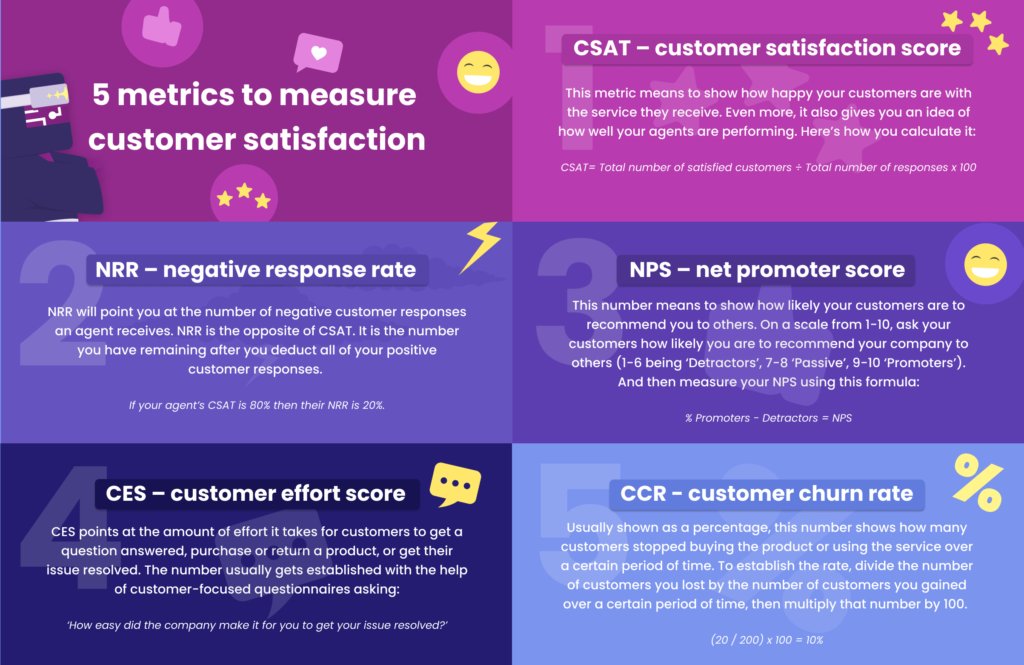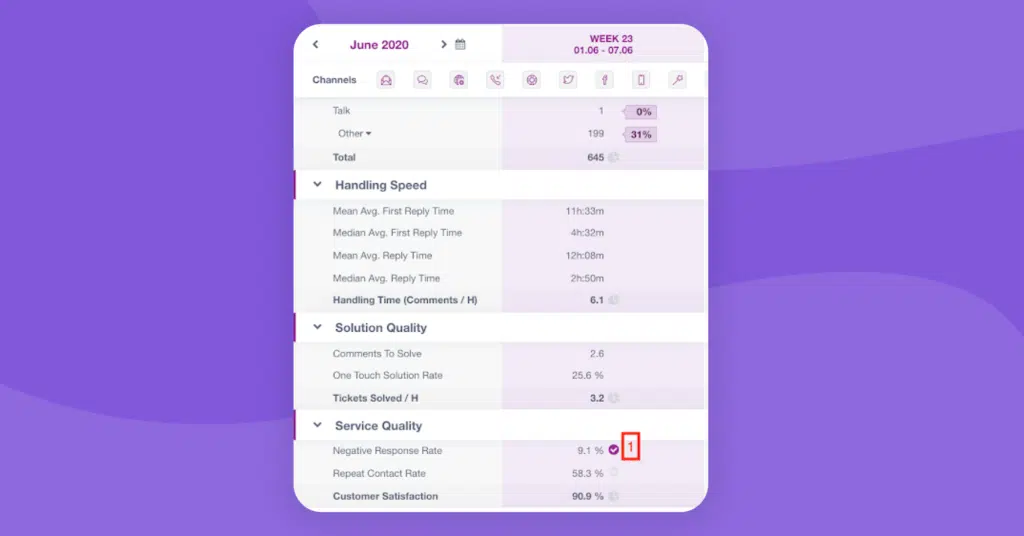Measuring customer satisfaction is not a nice-to-have, it is a must for your business to beat the competition. How so, you might wonder? For one thing, 96% of unhappy customers won’t get back to you with negative feedback, while 91% of them will leave and never come back.
While there are many different metrics you can measure in customer service, overall customer satisfaction is a vital one. So important that the customer satisfaction score (CSAT) is often set as one of the top key performance indicators (KPIs).
But, there are several metrics — in addition to the CSAT metric — that you can use to measure customer satisfaction such as the negative response rate and net promoter score for example. That’s why it’s crucial to understand how to measure customer satisfaction the right way. Each number will provide a different piece of the big picture to help you determine where you can improve and how happy your customers actually are.
Getting these pieces could be as simple as asking “How would you rate your overall satisfaction with the [product/service]?” across a range of mediums. There are many different ways to achieve the results you want.
Here, we’ll discuss the essential customer satisfaction metrics your team can focus on and how to measure them.
Why measuring customer satisfaction is important?
5 most important customer satisfaction metrics to analyze
Ways to gather data to measure customer satisfaction
The importance of measuring customer satisfaction
Customer satisfaction is the most important customer service metric — without satisfied customers, it will be hard to grow and sustain a profitable business. Analyzing customer satisfaction metrics will provide you with information about how happy your customers are, and what you can improve to provide a better overall experience.
It’s key to identify the customer service metrics you’ll measure to get more insights into your customers’ satisfaction levels. Deciding the metrics you’ll use to measure customer satisfaction for your company will guide you in creating a great customer experience, boosting retention rates, and measuring your agents’ performance.
When customers have a great experience, they’ll want to talk about it to their friends. The more they speak positively about your company, the more referrals you’ll get which improves your bottom line.
In today’s competitive business landscape, customer satisfaction plays a pivotal role in the success and growth of any organization. Satisfied customers are more likely to become loyal advocates, refer others to your business, and contribute to your bottom line. But how do you know if your customers are truly satisfied? That’s where measuring customer satisfaction comes into play.
Here are some key reasons why measuring customer satisfaction is of utmost importance:
- Understanding customer needs: By collecting feedback and measuring customer satisfaction, you gain valuable insights into what your customers truly desire. This understanding enables you to align your products, services, and customer support with their needs, preferences, and pain points. By meeting and exceeding their expectations, you can build long-lasting customer relationships and foster loyalty.
- Identifying opportunities for improvement: Measuring customer satisfaction helps you identify areas of your business that may be falling short. Whether it’s product quality, service delivery, or the overall customer experience, customer feedback provides valuable clues on areas that need improvement. By addressing these shortcomings, you can enhance your offerings, streamline processes, and deliver a better customer experience.
- Retaining customers and increasing loyalty: Satisfied customers are more likely to remain loyal to your brand, make repeat purchases, and recommend your products or services to others. On the other hand, dissatisfied customers are at a higher risk of churning and seeking alternatives. Measuring customer satisfaction allows you to proactively address concerns, resolve issues, and provide personalized experiences, thus increasing customer retention and fostering loyalty.
- Enhancing brand reputation: A satisfied customer not only becomes a loyal advocate but also contributes positively to your brand reputation. By consistently delivering exceptional customer experiences, you build a positive brand image and differentiate yourself from competitors. Positive word-of-mouth, online reviews, and social media mentions generated by satisfied customers can significantly impact your brand’s reputation and attract new customers.
- Driving business growth: Customer satisfaction is closely tied to business growth. Happy customers are more likely to spend more, make additional purchases, and become repeat buyers. They can also provide valuable feedback and insights that can drive innovation and help you expand your product or service offerings. By continuously measuring customer satisfaction, you can identify strategies to enhance customer value and drive business growth.
5 most important customer satisfaction metrics to analyze
To find out exactly how happy your customers are, you’ll want to identify customer satisfaction metrics that give you helpful insights. These insights can also help you improve your customer service performance. Here, we’ll discuss how to measure customer satisfaction and how to improve it.

1. CSAT – customer satisfaction score
The customer satisfaction score, or CSAT metric, is helpful in determining not only how happy your customers are, but also how well your agents are performing.
The CSAT calculation formula is as follows:
CSAT= Total number of satisfied customers ÷ Total number of responses x 100
This CSAT calculation will help you understand your score across all customers. It will also help you determine where your agents can improve or where you can tweak their training. After all, performance coaching is the new way to manage your customer support teams to make sure they experience continuous growth at the workplace.
Getting regular feedback from customers gives you a window into their minds. This insight makes it easier to increase your CSAT score as you’ll know firsthand how you can improve their overall experience.
For example, if a common customer complaint is having their call transferred too many times, you can identify new ways to train your agents so they’re prepared to answer all the most commonly asked questions during the first interaction.
2. NRR – negative response rate
The negative response rate (NRR) is also known as DSAT or BADSAT. It’s a metric used to measure the number of negative customer responses an agent receives. This means going through your customer feedback and calculating the number of responses that are under your positive satisfaction rate threshold.
For example, if your CSAT score ranges from 1-10, you may decide that anything under 8 is not acceptable.
The NRR is also related to the CSAT score as it’s the inverse of it. For example, if an agent’s CSAT is 75%, their NRR is 25%. Knowing this number helps you see the other side of the equation.
These direct insights allow your team to:
- Improve internal processes, products/services, and agent performance
- Drive customer retention and loyalty
- Increase employee motivation and engagement
3. NPS – net promoter score
While your CSAT score will tell you how happy your customers are, the net promoter score (NPS) will tell you how that satisfaction might translate into telling other people about your company. In other words, it’s how likely customers will be to recommend your company to others.
An astounding 92% of consumers will take friends and family’s recommendations into account when making a purchasing decision over any other form of advertising. Turning your customers into brand promoters can be your ultimate secret weapon.
To find your NPS, ask your customers the specific question of how likely they are to recommend your company, product, or service to their friends and family. Use a scale of 1-10; where 1 could be ‘not at all’ and 10 could be ‘definitely recommend’. You can then calculate your NPS by subtracting the percentage of detractors from that of promoters. The higher the score, the better.
Here’s an example. Let’s say 10% of your customers are detractors and 20% are promoters, your NPS is 10. If your score is above zero, you’re on the right track. Work to get fewer detractors than promoters in your surveys to crush your NPS goals.
4. CES – customer effort score
The amount of effort it takes for customers to get a question answered, purchase or return a product, or get their issue resolved is the customer effort score or CES. While this may sound like a vague metric, it’s definitely measurable, and improving it can increase customer satisfaction and brand advocacy.
On the other hand, not focusing on your CES score can result in customers speaking negatively about your company. In fact, 81% of people say they would speak poorly about difficult to work with products and services, while only 1% say they would speak badly about a company with easy-to-use products or services.
CES is measured by asking a single question of your customers and scoring the response on a scale, from 1 to 7 for example, with 1 representing the highest level of disagreement with the statement. You can then calculate the percentage of customers that at least ‘somewhat agree’ (those who give a 5 or above) with the statement that the company made it easy to resolve their issue.
These numbers will help you understand where there might be an opportunity for improvement in the customer service experience.
5. Customer churn rate
The customer churn rate is the number of customers who stop buying your products or services over a given time period. It’s usually expressed as a percentage and helps build a more complete view of customer satisfaction and overall business growth.
To calculate your customer churn rate, focus on a specific time period and divide the total number of lost customers by the total number of customers gained. Then multiply it to determine the percentage.
For example, let’s say in Q2 you acquired 300 new customers, but you lost 30. Your customer churn rate would be calculated like this:
(30 / 300) x 100 = 10%
Another way to calculate customer churn is by dividing the number of customers lost in a period by the total number of customers at the beginning of the same period.
The average customer churn rate across industries is around 20-21%. For a company to grow, the number of new customers in a given period (growth rate) must surpass its customer churn rate.
Measure your ‘true’ CSAT
One aspect of CSAT is negative reviews that bring down your agents’ rates. Most of the time, your customer is providing valuable feedback about your agents to help them improve. Sometimes, however, there are situations where this is not the case. After all, negative feedback could be sent for a quality assurance review because the circumstance for the customer was beyond the agent’s control, which can be highly demotivating.
With Kaizo’s Scorecard, authorized agents (and their Team Leads) are able to challenge a negative review and potentially bring down their NRR by choosing a specific review and clicking ‘out’ to exclude it from their overall NRR score.

Calculating your true CSAT score means allowing your agents to receive a fair evaluation and scoring. This will motivate them rather than bring them down to feel like they have zero control over their metrics.
7 ways to measure customer satisfaction
You may be wondering what methods you can use to receive and evaluate feedback from customers. The truth is, you simply need to ask for it. Here are four ways to find out exactly what your customers want and so you can measure customer satisfaction.
1. Online surveys
Putting together a survey is fairly straightforward, but you’ll want to put thought into it. Take care to include a reasonable number of questions and to gather the information that’s most important.
Use questions that help add to your determined CSAT metrics. Make the questions simple to answer, not too lengthy, easy to understand, and helpful for your company and agents.
Conducting customer surveys is a popular and direct method to gauge customer satisfaction. Surveys can be administered through various channels, such as email, online forms, or in-app surveys.
Design your surveys to capture both quantitative and qualitative feedback, including rating scales, open-ended questions, and Net Promoter Score (NPS) measurements. Analyzing survey responses provides valuable insights into customer perceptions, preferences, and areas where improvements can be made.
2. Email
While you can email the survey you’ve created, you can also use customer service email templates to ask people for feedback. Post-purchase follow-up emails are also a great strategy to get insights from customers. You can ask them about their experience and what you can improve.
Let customers reply directly to these emails to make it easier for them to get in touch. This will also add a personal touch and hopefully make it more conversational so you can truly understand their feedback.
3. Social media or community forum
Nearly half of consumers say they would share a positive customer experience on social media. And 34% of people use social media to discover or learn about new products, services, and brands. If people are talking about your company on social media, you’ll want to know what they’re saying.
Fortunately, there are many social listening tools to help keep track of this. Sometimes, though, going through a handful of social media posts yourself can be the best way to see what people really think. You could even set up a simple Google Alert to help you.
If you have the resources, you can also create a community forum on your website. Make it a place where customers can discuss questions, challenges, praises, and more. This way, you can learn what people love, hate, and everything in between directly from your own site.
4. Live chat or phone call
Adding a live chat function to your website makes it easier for customers to get in touch, which makes it easier to receive feedback. The same goes with offering phone support. Once customers start a chat or call your support center, agents can personally ask if they’re satisfied with the service they received. This is usually a simple yes or no question, however, and doesn’t give you a specific number.
For customers who may not be open to providing feedback directly, you can incorporate an in-app or on-call satisfaction feature. These automations ask customers after your conversation whether they were helped and if they’re satisfied with the service. This will also provide you with more specific, measurable results.
5. Analytics
Numbers can tell you much more than you think they can. For one thing, your website traffic and bounce rate do not just show how popular your website is — they also show you how satisfied your customers are with their online experience with the service.
You can take a moment to analyze how long people stay on each specific webpage, how many of them subscribe or unsubscribe from your newsletter, and what their journey from one webpage to another webpage is like. It is the type of data you always have available and do not need to reach out to your customers.
6. Customer feedback and reviews
Monitoring and analyzing customer feedback and reviews is an essential way to measure customer satisfaction. This includes online reviews on platforms like Google, Yelp, or social media, as well as direct feedback received via customer support channels.
Pay attention to both positive and negative feedback, as they can highlight strengths and weaknesses in your offerings. Encourage customers to share their feedback by providing accessible feedback mechanisms and actively responding to their concerns.
7. Customer interviews and focus groups
Engaging customers through interviews and focus groups allows for more in-depth conversations and qualitative insights. By conducting one-on-one interviews or assembling a small group of customers, you can explore their experiences, perceptions, and expectations in detail.
This qualitative data provides rich insights into the emotions, motivations, and specific pain points of your customers. Use these insights to uncover hidden issues and identify opportunities for improvement.
Improve how you measure customer satisfaction
Measuring customer satisfaction is a vital component of any successful business strategy. It allows you to gain insights, identify areas for improvement, retain customers, enhance brand reputation, and drive business growth. By prioritizing customer satisfaction and leveraging the data collected through measurement, you can build a customer-centric organization that thrives in today’s competitive marketplace.
When it comes to customer satisfaction metrics, evaluating and calculating them may feel time-consuming. But each one is important to help you learn about your customers, improve your team’s performance, and inform business decisions that drive up retention and revenue.
Automate calculating these metrics with Kaizo’s Scorecards and get a 360° view of agents’ performance at any point in time. Our real-time agent performance sheet will make it easy for you to track and analyze performance, measure progress, and automate report creation.


